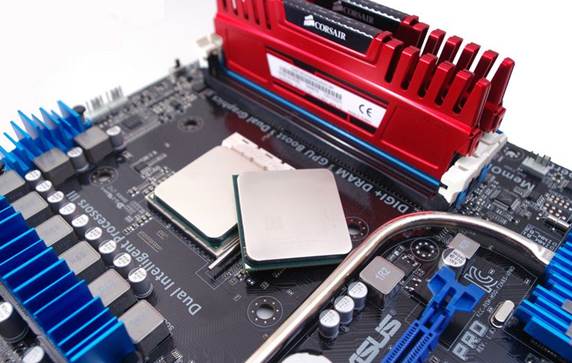Accelerated Processing
Unit (APU)
AMD launched its first APU - Accelerated
Processing Unit, a CPU and GPU combined into one chip codenamed Llano along
with the Fusion platform back in 2011, which was followed up with the Trinity
series in 2012. Here in 2013 we now welcome the latest range known as Richland.
The first Richland APU we received for
testing was the quad core A10-6800K, which replaces the older A10-5800K chip.
Looking at the specs list, it doesn't look like much has changed to be
perfectly honest.
The old Al0-5800Khadabase CPU speed of
3.8GHz (4.2GHz Turbo) and 384 GPU cores running at 800MHz. This new A10 - 6800K
chip only marginally ramps things up with a base speedof4.1GHz (4.4GHzTurbo)
and the same amount of GPU cores running at 844MHz.

The
first Richland APU we received for testing was the quad core A10-6800K, which
replaces the older A10-5800K chip.
In all other respects, there don’t seem to
have been any upgrades. The A10-6800K is built on the same Piled river CPU
microarchitecture at 32nm, uses the same FM2 motherboards, is still rated to
draw 100W, and has the same 4MB of L2 cache.
It also has the same GPU microarchitecture,
despite upgrading the model number of the GPU from HD 7660D to HD 8670D, which
would usually imply that there is a generational difference at least.
One thing that has changed is the A10 -
6800K now officially supports DDR3- 2133 memory. This is possibly limited to a
marketing upgrade as the old A10-5800K had no problems running my DDR3-2133 RAM
at its full speed in the first place.

Pure
CPU performance doesn't stack up quite so well, however bear in mind the price
differences.
As the saying goes, however, 'if it isn’t
broke, don’t fix it'. One thing the FusionAPUs have always excelled at is GPU
performance, and looking at the stats we can see that the A10-6800K extends an
already formidable gap in gaming performance between it and the much more
expensive Intel HD Graphics 4000/4600 found in the i5-3570K/i7-4770K chips.
Pure CPU performance doesn't stack up quite
so well, however bear in mind the price differences. Intel's latest fourth-
generation Haswell chip, the i7-4770K, does indeed double the performance of
the AMD chip in the multi-threaded CPU test, but it costs over twice as much -
not including the fact that motherboards for Haswell chips are generally more
expensive than those AMD's APUs. Dollar-for-dollar, theA10-6800Kactuallyputs up
a decent fight.
It's clear that AMD needs to bring a new
CPU microarchitecture to the table to close the performance gap with Intel. It
is a rosier picture on the GPU side of the fence though, and that is the value
proposition than AMD will be pushing with these chips, particularly around the
fact that you can drive three monitors in an Eyefinity arrangement straight out
of the box without the need for a dedicated graphics card.

It's
clear that AMD needs to bring a new CPU microarchitecture to the table to close
the performance gap with Intel.
Speaking of which, you would need to spend
somewhere around the $120 mark to get a dedicated graphics card with the same
performance and capabilities as the integrated GPU in the A10-6800K. Not bad
value considering this APU only costs a smidgeon over $200 in the first place.
All up I have the same conclusion about the
A10-6800K as I did with its predecessor. Despite losing to Intel in the CPU
performance stakes, it's a great chip if you're on a tight budget and want to
build a PC with light gaming or a multiple-monitor arrangement in mind.
|
At a glance
·
4.1GHz (4.4GHzTurbo) quad-core APU
·
Integrated HD 8670DGPU
·
Capable of playing moderately demanding 3D
games
·
Quite far behind Intel in terms of CPU
performance
AMDA10-6800
·
RRP inci GST; $215 (Retail)
·
Contact: amd.com
·
Rating: 3.5/5
·
Low price APU with excellent gaming
capability, but short on raw CPU power compared to Intel's offerings.
|